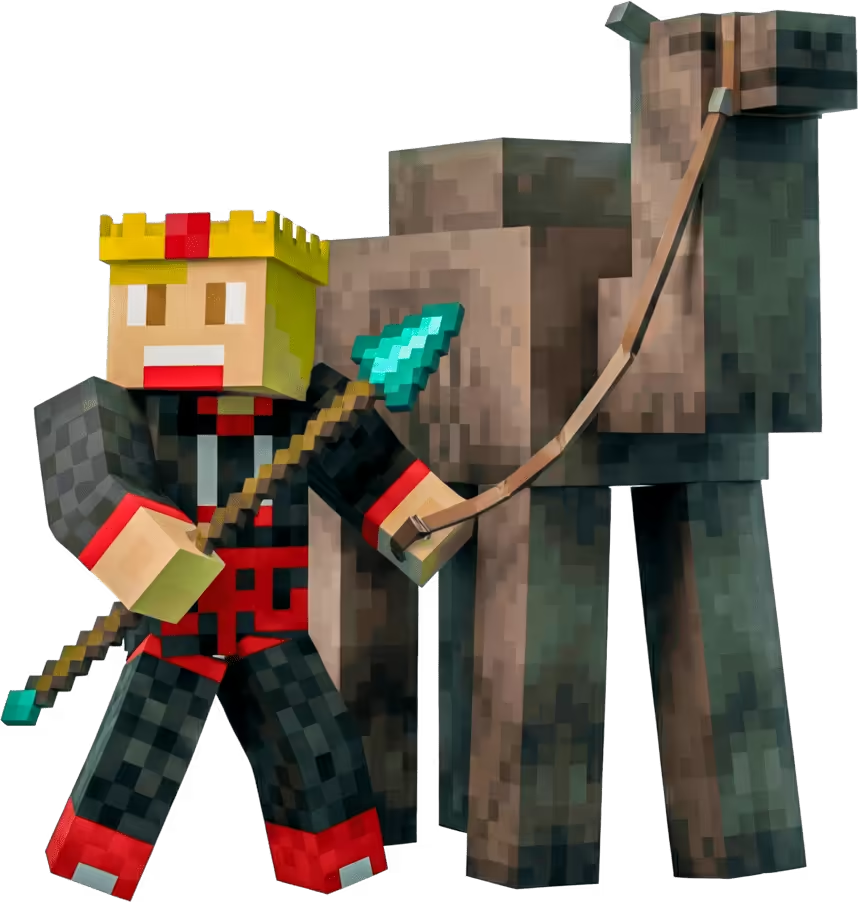Running your own Minecraft server in 2025 is easier than ever (thanks to shared hosting) but choosing the right hardware requirements is still one of the trickiest parts. If you get it wrong, your server might lag, crash, or struggle to handle players and mods. If you get it right, you’ll have a smooth, scalable experience.
This guide breaks down RAM, CPU, network and storage requirements. It’s written for beginners looking to set up their first server or upgrade to a better host.
Why Are RAM, CPU, Network & Storage Important?
Every Minecraft server relies on four main hardware components that determine its performance:
| Component | What It Does |
|---|---|
| CPU | Drives critical computations: redstone, mobs, chunks, entities |
| RAM | Keeps track of everything happening in the world while the game is running. |
| Storage (Disk) | Saves worlds, mods, plugins, and backups |
| Network | Controls player connectivity and ping |
As the Minecraft server world keeps evolving with mods and game updates, imbalances here can cause heavy lag, data loss or downtime.
Hardware Requirements For Minecraft Servers
There isn’t a single “perfect setup” for everyone, it depends on the server size, mods, and hosting type (shared, VPS, or dedicated). But there are general requirements and advice for each major component.
I'll try to give you an overview of requirements for each so whether you are running a private modded server with friends or a public server, you know exactly what to go for.
RAM
How much RAM you need depends on three major things: player count, activity and type of server (are there mods, plugins?).
| Server type | Players Online | Mods/Plugins | Activity level | Start with this RAM |
|---|---|---|---|---|
| Vanilla (Small) | 2–10 | - | Low–moderate | 4–5 GB |
| Lightly Modded (Small) | 2-10 | 0-100 Mods | Moderate | 5–6 GB |
| Heavily Modded (Small) | 2-10 | 100-250+ Mods | High | 8–12 GB |
| Plugin Servers (Big) | 15-40 | 10-60 Plugins | Moderate | 6-8 GB |
| Community Servers | 100+ | 20-60 Plugins | Very High | +12 GB |
If you start picking RAM for your server, it might seem attractive to just save some money and only buy 2GB or 3GB RAM (which most hosting providers offer) but unless you are running a minigame with a few friends it's not recommended to go below 4GB.
CPU
CPU is critical for your server performance. Minecraft's server softwares rely heavily on single-thread performance, where one core handles critical tasks like world ticking, entity updates, redstone logic, and chunk loading.
As of 2025, AMD Ryzen dominates for Minecraft servers due to superior single-core efficiency, stability, and value.
| Tier | CPU Models | Performance |
|---|---|---|
| Top-Tier | Ryzen 7 7800X3D, Ryzen 7 5800X3D | ⭐⭐⭐⭐⭐ |
| High-End | Ryzen 9 7950X3D, Ryzen 9 9950X3D | ⭐⭐⭐⭐ |
| Balanced | Ryzen 7 5800X, Ryzen 5 5600, Ryzen 7 7700 | ⭐⭐⭐⭐ |
| Entry-Level | Ryzen 5 5600, Ryzen 5 7600, Ryzen 7 5700X | ⭐⭐⭐ |
Upgrading to a better CPU delivers tangible benefits:
- Faster startups (a Paper server boots in 15s vs. 30s)
- Quicker chunk generation (20–25% faster, reducing exploration lag)
- Higher player capacity before TPS drops (20 players at 20 TPS vs. at 18 TPS).
A better CPU ensures quicker launches, smoother runs, and lag-free scaling.
Storage Drives: HDD, SSD & NVMe
Storage serves as your Minecraft server's hard drive, safeguarding everything that defines your world, from terrain and structures to player inventories and backups.
Storage comes in different types based on technology, speed, and reliability, which directly impact performance, like how quickly chunks load or autosaves happen without lag.
Here's a breakdown of common types:
| Storage Type | Speed | Reliability |
|---|---|---|
| HDD | 🐢 Slow (80–150 MB/s) | 🟠 Moderate |
| SSD | ⚡ Fast (400–550 MB/s) | 🟢 High |
| NVMe | 🚀 Ultra-fast (2000–7000 MB/s) | 🟢 High |
Storage Capacity
Storage needs vary by server type, mods, plugins, players and more. For most worlds 10GB is enough but if you are looking to have more players, activity, mods or plugins, you might be looking around 15-40GB of storage.
Here's a general guideline for storage needs:
| Server Type | Player Count | Recommended Storage | Notes |
|---|---|---|---|
| Vanilla Survival | 5–10 | 2–10 GB | Perfect for short-term playing with friends. |
| Modded (Forge/Fabric) | 5–15 | 10–30 GB | Perfect for most cases. Gives you room for backups too. |
| Plugin-Heavy (Spigot/Paper) | 10–30 | 15–40 GB | Usually recommended for smaller public servers. |
| Hub Network | 20–100 | 30–80 GB | Multiple worlds, lobbies, schematics. |
| Large Community Server | 100+ | 100 GB – 500 GB+ | This can vary a lot. Massive worlds take up lots of space. |
Network Requirements
Your server’s network connection determines how smooth gameplay feels, it affects ping, lag, and stability more than most people realize.
Even if you have a powerful CPU and plenty of RAM, a poor network setup can make your server unplayable for other players.
Server Location
The closer your server is to your players, the lower the ping (delay between player and server). Every extra 1,000 km of distance adds roughly 10–20 ms of latency, and once you pass 100 ms, gameplay starts feeling noticeably sluggish.
If you have players from multiple continents, choose a central region to balance ping for everyone.
Bandwidth & Speed
Bandwidth is how much data your server can send and receive per second. Minecraft isn’t extremely bandwidth-heavy, but you still need a stable connection, especially for multiple players.
| Server Size | Minimum Upload Speed | Recommended |
|---|---|---|
| Small (1–5 players) | 10 Mbps | 20–50 Mbps |
| Medium (10–20 players) | 50 Mbps | 100 Mbps |
| Large (50+ players) | 100 Mbps+ | 1 Gbps dedicated uplink |
DDoS Protection
Minecraft servers are frequent targets of DDoS attacks, especially public or community servers. Without proper protection, your IP can be flooded with fake traffic, causing lag or full downtime.
Look for hosts that provide:
- Enterprise-level DDoS protection
- Always-on filtering (not just reactive)
- Automatic mitigation during large attacks
Software Requirements
Good hardware means nothing without the right software setup. Minecraft servers run on Java, and choosing the right version, configuration, and server type makes a huge difference in performance, stability, and plugin compatibility.
Java Version (Use Java 21 or Later)
Minecraft Java Edition servers run inside the Java Virtual Machine (JVM) which is what interprets the game’s code and manages memory.
Server Software (Paper, Forge, Fabric, Vanilla etc)
Your hardware defines how powerful your server can be, but your server software determines how efficiently that power is used.
Even the best CPU and 32 GB of RAM won’t help if your server jar is unoptimized, outdated, and full of inefficient plugins. That’s why choosing the right software stack matters as much as picking the right hardware.
| Server Type | Description | Performance | Plugin/Mod Support |
|---|---|---|---|
| Vanilla | Official Mojang server, no modifications | 🚫 Poor | 🚫 None |
| PaperMC | Recommended for most servers. | ⚡ Great | ✅ Plugins |
| Purpur | Paper fork with extra tweaks & config options | ⚡⚡ Excellent | ✅ Plugins |
| Spigot | Older performance Vanilla | 👍 Good | ✅ Plugins |
| Forge | Mod loader for client + server mods | 👍 Good | ✅ Forge mods |
| Fabric | Lightweight mod loader alternative to Forge | ⚡ Great | ✅ Fabric mods |
| Mohist / Magma | Hybrid server types. Can run mods & plugins together. | ⚠️ Unstable | ✅ Both plugins & mods |
Optimization – How to Make Your Server Run Better
There are many ways to optimize a Minecraft server to reduce the resources it needs, and often, smart optimizations can feel like a free hardware upgrade.
In this section, we’ll go through the most effective ways to make your server run smoother, use less CPU and RAM, and keep lag to a minimum.
1. Use Optimized Server Software
The easiest win: switch from Vanilla to a performance-optimized fork like Paper or Purpur. These versions are built by the Minecraft developer community to improve efficiency without changing gameplay.
2. Optimize Your View Distance
View Distance (and Simulation Distance) controls how many chunks are loaded around each player. The higher the value, the more your CPU and RAM need to process. Reduce both view and simulation distance to improve performance.
3. Limit Entities and Redstone
Entities (mobs, dropped items, armor stands) and complex redstone contraptions are the biggest lag sources in Minecraft.
You can reduce the load by:
- Limiting mob farms and item drops
- Using plugins like ClearLag or Spark to track performance
- Setting entity caps in your
spigot.ymlorpaper.yml - Disabling hopper ticking or reducing tile entity updates
4. Use Proper JVM Flags
JVM flags tell Java how to handle memory and garbage collection (cleaning up unused data). Using optimized flags like Aikar’s JVM Flags can make a huge difference.
There are countless of other small ways you can optimize your server performance. I encourage you to check out this guide for more in-depth guide on server optimization.
WiseHosting – The Hosting Optimized for Minecraft Servers

All the things we’ve covered, from CPU and RAM to storage, network, and optimization matter only if your host gives you hardware and software built for Minecraft. That’s exactly what WiseHosting is doing.
Unlike generic game hosts, WiseHosting was built exclusively for Minecraft, by the YouTubers Shulkercraft (2.3M+ subscribers).
Every part of the platform: hardware, control panel, support, and presets is optimized for one goal: making Minecraft servers fast, stable, and easy to manage.
⚡ Performance That Speaks for Itself
WiseHosting runs on modern AMD Ryzen CPUs known for their unbeatable single-core speed, exactly what Minecraft needs most.
🌍 9 Different Locations Globally
With servers across Europe, North America, and Asia, WiseHosting gives you ping tests and recommendations on places where your server performs best.

💬 Minecraft-specific Support, 24/7
Every member of the WiseHosting support team knowns ins and outs of running Minecraft servers, they’re not generic “tech agents” or "gaming enthusiasts". So when you need help with plugins, modpacks, or performance tuning, you’re talking to someone who actually runs servers themselves.
Conclusion
Running a Minecraft server today is simpler than ever, but getting the hardware right is what separates a smooth experience from one that constantly causes problems with lag and crashes.
Balanced hardware gives your players stable TPS, quick chunk loading, and low ping even with dozens (or hundreds) of active players.



 Carl S.
Carl S.

